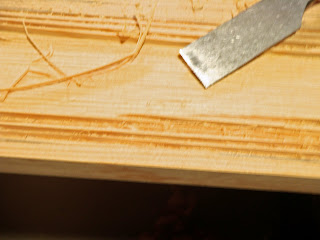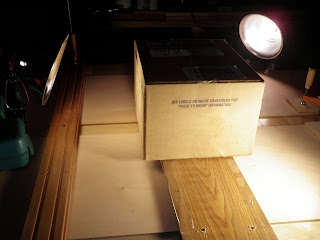Sing It Willy Tea
-
“I’m a laid back one, and I been one so long…” Willy Tea Taylor “Wrong Way
To Go”
8 years ago
Boats are simple. Owning one is complex. Here we'll separate the wheat from the chaff-or, if you like, the best from the bilge-in order to make your boating experience more enjoyable.

 As described in Part 21, these quarter knees were cut carved and shaped from a glue-up of 1" x 4" pine . That way I didnt end up with "short grain" along one of the "arms" ( You always want wood grain to follow the load paths.) Shaping was done with a low angle block plane, a spokeshave and a rasp. The rough shape was cut with a jigsaw. These will be installed 1/8" high of the sides and transom, then planed flush for a mating fit.
As described in Part 21, these quarter knees were cut carved and shaped from a glue-up of 1" x 4" pine . That way I didnt end up with "short grain" along one of the "arms" ( You always want wood grain to follow the load paths.) Shaping was done with a low angle block plane, a spokeshave and a rasp. The rough shape was cut with a jigsaw. These will be installed 1/8" high of the sides and transom, then planed flush for a mating fit.
 I made my quarter knees--the corner braces at the transom-from a glue-up of 1-by pine.I lapped the corners and and sed four boards for each "blank." I the cut the actual knees to shape, beveling their sides to fit the flare of the boat sides and the rake of the transom.
Gluing up this way allowed me to orient the grain in the direction of the stresses. It is stronger than a solid piece of wood and easier than laminating curved pieces or steam bending.
Here's a pic of the blanks in which you can see how I arranged the overlapping glue-up. I will post a picture of the final shaped knees later. Here, I have beveled the arms that rest along the transom, using a block plane. More shaping and beveling to come.
I made my quarter knees--the corner braces at the transom-from a glue-up of 1-by pine.I lapped the corners and and sed four boards for each "blank." I the cut the actual knees to shape, beveling their sides to fit the flare of the boat sides and the rake of the transom.
Gluing up this way allowed me to orient the grain in the direction of the stresses. It is stronger than a solid piece of wood and easier than laminating curved pieces or steam bending.
Here's a pic of the blanks in which you can see how I arranged the overlapping glue-up. I will post a picture of the final shaped knees later. Here, I have beveled the arms that rest along the transom, using a block plane. More shaping and beveling to come.
 First coat of paint went on and I'm happy with the job I did sanding and fairing. Cant see the 'glass om the chines. Ok, I can, up close, but it came out really good. If you are sharp-eyed, you'll notice I have'nt yet painted the port side of the boat--thats the side on the right in the photo. There, you can see the biaxial glass cloth.
I'm treating this first coat as a prime coat anyhow: it showed the high spots and other minor imperfections that where hard to see on the unpainted wood. Most of this coat will get sanded off, then I'll aplly the "real" first coat--and then one more!.
That messy rubrail low in the picture? Thats masking tape. Those rails are going to be finished natural.
First coat of paint went on and I'm happy with the job I did sanding and fairing. Cant see the 'glass om the chines. Ok, I can, up close, but it came out really good. If you are sharp-eyed, you'll notice I have'nt yet painted the port side of the boat--thats the side on the right in the photo. There, you can see the biaxial glass cloth.
I'm treating this first coat as a prime coat anyhow: it showed the high spots and other minor imperfections that where hard to see on the unpainted wood. Most of this coat will get sanded off, then I'll aplly the "real" first coat--and then one more!.
That messy rubrail low in the picture? Thats masking tape. Those rails are going to be finished natural.














































This new ship here is fitted according to the reported increase of knowledge among mankind. Namely, she is cumbered end to end with bells and trumpets and clocks and wires. It has been told to me she can call voices out of the air or the waters to con the ship while her crew sleep. But sleep though lightly. It has not yet been told to me that the sea has ceased to be the sea.
